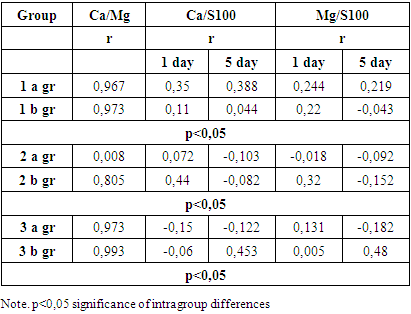-
Paper Information
- Next Paper
- Previous Paper
- Paper Submission
-
Journal Information
- About This Journal
- Editorial Board
- Current Issue
- Archive
- Author Guidelines
- Contact Us
American Journal of Medicine and Medical Sciences
p-ISSN: 2165-901X e-ISSN: 2165-9036
2023; 13(5): 633-636
doi:10.5923/j.ajmms.20231305.18
Received: Apr. 22, 2023; Accepted: May 12, 2023; Published: May 17, 2023

Shifts as Markers of Perinatal Damage of the Central Nervous System
Fayzullaeva Khilola Bahronovna
Assistant of the Department of Biological Chemistry, Samarkand State Medical University, Samarkand, Uzbekistan
Correspondence to: Fayzullaeva Khilola Bahronovna, Assistant of the Department of Biological Chemistry, Samarkand State Medical University, Samarkand, Uzbekistan.
| Email: |  |
Copyright © 2023 The Author(s). Published by Scientific & Academic Publishing.
This work is licensed under the Creative Commons Attribution International License (CC BY).
http://creativecommons.org/licenses/by/4.0/

Perinatal lesions of the Central nervous system occupy a leading place in the structure of morbidity in newborns. In this regard, we set ourselves the task of evaluating the activity of the S100B neurotest as a marker of perinatal CNS damage in posthypoxic syndrome, depending on the severity of asphyxia; compare metabolic shifts with neurotest indicators in dynamics; highlight the correlation between S100B and Ca, Mg serum levels as components of the formation of perinatal lesions of the central nervous system. According to the results obtained from the isolated signs of multiple organ failure, a high level of S100 neurotest in combination with hypoglycemia can be considered a certain clinical and laboratory predictor of the formation of neurological symptoms and long-term consequences against the background of obvious clinical signs. Correlation analysis of the relationship between Ca and Mg showed a high positive statistically significant relationship with neonatal asphyxia, especially with body weight shifts, regardless of the severity of asphyxia, and a moderately and weakly positive and in some cases negative correlation with S100/Ca, S100/Mg, which confirms the predominance of S100 as the leading laboratory neurotest in neonatal asphyxia.
Keywords: Newborns, S100 neurotest, Hypocalcemia, Hypomagnesemia
Cite this paper: Fayzullaeva Khilola Bahronovna, Shifts as Markers of Perinatal Damage of the Central Nervous System, American Journal of Medicine and Medical Sciences, Vol. 13 No. 5, 2023, pp. 633-636. doi: 10.5923/j.ajmms.20231305.18.
1. Introduction
- Hypoxic - ischemic encephalopathy resulting from hypoxia, underlies the delay in psychomotor development in the first year of life, the formation of attention deficit hyperactivity disorder, cerebral palsy, motor and cognitive disorders [6,7].In this regard, early diagnosis of the severity of hypoxia and the associated CNS damage is of particular importance for the choice of adequate therapy and in the preparation of health procedures and medical correction during further medical examination, taking into account the risk of developing long-term neurological symptoms [1,3,10].A great role is given to the assessment of the marker of perinatal damage to the central nervous system according to the S100B neurotest. Also, the role of hypoglycemia, hypocalcemia, hypomagnesemia and a decrease in the level of phosphorus in the blood of a newborn is not excluded, as components of the formation of metabolic disorders indirectly creating a background for neurological symptoms [2,4,9].
2. Literature and Methodology
- To accomplish this task, 60 full-term newborns born with a history of asphyxia were examined. Diagnosis according to WHO criteria (2008). Depending on body weight and severity of asphyxia, groups of patients wereI- body weight less than 2500.0 gII- Normal body weight at birthIII- body weight over 4000gAccording to the severity of asphyxia, each group is divided into subgroups: a-moderate asphyxia, b-severe asphyxia. Research methodology-marker neurotest S100B by ELISA, the level of glucose, calcium, magnesium, phosphorus was determined on the Merilyzer Clini Quant apparatus.
3. Results and Discussion
- Of the observed newborns, up to 60% were dominated by boys. Analysis of anamnestic data on maternal health showed the predominance of:Leading factors of antenatal hypoxia: acute infections of the upper respiratory tract - 80%; anemia - 63%; placental insufficiency - 43%; caesarean section - 40%; thyroid disease - 40%; pathology of the urinary system - 36%; hypertension disorder - 34%; inflammatory diseases of the pelvic organs in women - 28%.Leading intranatal factors of acute asphyxia: childbirth and delivery, complicated by fetal stress - 80%; cord entanglement - 40%; premature detachment of the placenta - 36%; violations of labor activity - 35%; severe preeclampsia - 30%; the onset of labor after a 24-hour waterless period - 28%; premature rupture of membranes - 22%. In more than half of the cases, a combination of 2-3 factors was identified. Thus, there is such a picture of a combination of leading factors: deterioration of maternal blood oxygenation 76%; interruption of blood flow through the umbilical cord 45%; violation of gas exchange through the placenta 40%; insufficiency of respiratory efforts of the newborn 28%; inadequate hemoperfusion of the maternal part of the placenta 25%;.Patients are monitored in accordance with the rule of clinical, instrumental and laboratory monitoring according to indications and to the extent necessary. The neurotest marker S100B was tested in observed newborns in the first hours and on the fifth day of life. (tab. 1)
|
|
4. Conclusions
- Of the identified signs of multiple organ failure, a high level of S100 neurotest in combination with hypoglycemia can be considered a certain clinical and laboratory predictor of the formation of neurological symptoms and long-term consequences against the background of obvious clinical signs.Correlation analysis of the relationship between Ca and Mg showed a high positive statistically significant relationship with neonatal asphyxia, especially with body weight shifts, regardless of the severity of asphyxia, and a moderately and weakly positive and in some cases negative correlation with S100/Ca, S100/Mg, which confirms the predominance of S100 as the leading laboratory neurotest in neonatal asphyxia.
 Abstract
Abstract Reference
Reference Full-Text PDF
Full-Text PDF Full-text HTML
Full-text HTML
